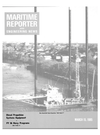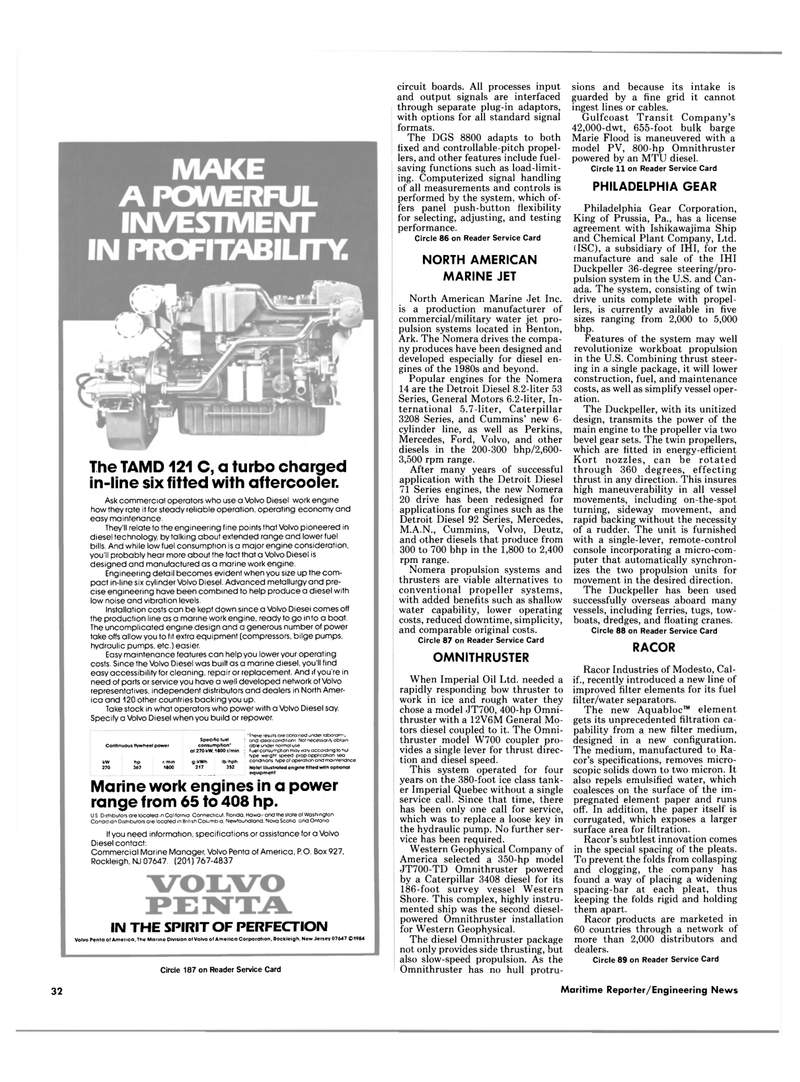
Page 30: of Maritime Reporter Magazine (March 15, 1985)
Read this page in Pdf, Flash or Html5 edition of March 15, 1985 Maritime Reporter Magazine
The TAMD121 C, a turbo charged in-line six fitted with aftercooler.
Ask commercial operators who use a Volvo Diesel work engine how they rate it for steady reliable operation, operating economy and easy maintenance.
They'll relate to the engineering fine points that Volvo pioneered in diesel technology, by talking about extended range and lower fuel bills. And while low fuel consumption is a major engine consideration, you'll probably hear more about the fact that a Volvo Diesel is designed and manufactured as a marine work engine.
Engineering detail becomes evident when you size up the com- pact in-line six cylinder Volvo Diesel. Advanced metallurgy and pre- cise engineering have been combined to help produce a diesel with low noise and vibration levels.
Installation costs can be kept down since a Volvo Diesei comes off the production line as a marine work engine, ready to go into a boat.
The uncomplicated engine design and a generous number of power take offs allow you to fit extra equipment (compressors, bilge pumps, hydraulic pumps, etc.) easier.
Easy maintenance features can help you lower your operating costs. Since the Volvo Diesel was built as a marine diesel, you'll find easy accessibility for cleaning, repair or replacement. And if you're in need of parts or service you have a well developed network of Volvo representatives, independent distributors and dealers in North Amer- ica and 120 other countries backing you up.
Take stock in what operators who power with a Volvo Diesel say.
Specify a Volvo Diesel when you build or repower. •These results arc obtair ed under labora' •,
Specific fuel :nd idea ondition' Not necessarily oh'a n
Continuous flywheel power consumption* able under normal use at 270 kW, 1800 r/min | Fuel consumption mav vary according to hul i I type weight speed prop opplication sea kw hp r/min g/kWh tb/hph conditions typeot operation and marntendnce 270 367 1800 217 .352 Note! Illustrated engine fitted with optional equipment
Marine work engines in a power range from 65 to 408 hp.
US Distributors are located in California Connecticut. Florida Hawaii and the state of Washington
Canadian Distr Dutors are located in British Columbia, Newfoundland. Nova Scot a and Ontario
If you need information, specifications or assistance for a Volvo
Diesel contact:
Commercial Marine Manager, Volvo Penta of America, P.O. Box 927,
Rockleigh, NJ 07647. (201)767-4837
IN THE SPIRIT OF PERFECTION
Volvo Penta ot America, The Marine Division ot Volvo ot America Corporation, Rockleigh, New Jersey 07647 ©1984
Circle 187 on Reader Service Card circuit boards. All processes input and output signals are interfaced through separate plug-in adaptors, with options for all standard signal formats.
The DGS 8800 adapts to both fixed and controllable-pitch propel- lers, and other features include fuel- saving functions such as load-limit- ing. Computerized signal handling of all measurements and controls is performed by the system, which of- fers panel push-button flexibility for selecting, adjusting, and testing performance.
Circle 86 on Reader Service Card
NORTH AMERICAN
MARINE JET
North American Marine Jet Inc. is a production manufacturer of commercial/military water jet pro- pulsion systems located in Benton,
Ark. The Nomera drives the compa- ny produces have been designed and developed especially for diesel en- gines of the 1980s and beyond.
Popular engines for the Nomera 14 are the Detroit Diesel 8.2-liter 53
Series, General Motors 6.2-liter, In- ternational 5.7-liter, Caterpillar 3208 Series, and Cummins' new 6- cylinder line, as well as Perkins,
Mercedes, Ford, Volvo, and other diesels in the 200-300 bhp/2,600- 3,500 rpm range.
After many years of successful application with the Detroit Diesel 71 Series engines, the new Nomera 20 drive has been redesigned for applications for engines such as the
Detroit Diesel 92 Series, Mercedes,
M.A.N., Cummins, Volvo, Deutz, and other diesels that produce from 300 to 700 bhp in the 1,800 to 2,400 rpm range.
Nomera propulsion systems and thrusters are viable alternatives to conventional propeller systems, with added benefits such as shallow water capability, lower operating costs, reduced downtime, simplicity, and comparable original costs.
Circle 87 on Reader Service Card
OMNITHRUSTER
When Imperial Oil Ltd. needed a rapidly responding bow thruster to work in ice and rough water they chose a model JT700, 400-hp Omni"- thruster with a 12V6M General Mo- tors diesel coupled to it. The Omni- thruster model W700 coupler pro- vides a single lever for thrust direc- tion and diesel speed.
This system operated for four years on the 380-foot ice class tank- er Imperial Quebec without a single service call. Since that time, there has been only one call for service, which was to replace a loose key in the hydraulic pump. No further ser- vice has been required.
Western Geophysical Company of
America selected a 350-hp model
JT700-TD Omnithruster powered by a Caterpillar 3408 diesel for its 186-foot survey vessel Western
Shore. This complex, highly instru- mented ship was the second diesel- powered Omnithruster installation for Western Geophysical.
The diesel Omnithruster package not only provides side thrusting, but also slow-speed propulsion. As the
Omnithruster has no hull protru- sions and because its intake is guarded by a fine grid it cannot ingest lines or cables.
Gulfcoast Transit Company's 42,000-dwt, 655-foot bulk barge
Marie Flood is maneuvered with a model PV, 800-hp Omnithruster powered by an MTU diesel.
Circle 11 on Reader Service Card
PHILADELPHIA GEAR
Philadelphia Gear Corporation,
King of Prussia, Pa., has a license agreement with Ishikawajima Ship and Chemical Plant Company, Ltd. (ISC), a subsidiary of IHI, for the manufacture and sale of the IHI
Duckpeller 36-degree steering/pro- pulsion system in the U.S. and Can- ada. The system, consisting of twin drive units complete with propel- lers, is currently available in five sizes ranging from 2,000 to 5,000 bhp.
Features of the system may well revolutionize workboat propulsion in the U.S. Combining thrust steer- ing in a single package, it will lower construction, fuel, and maintenance costs, as well as simplify vessel oper- ation.
The Duckpeller, with its unitized design, transmits the power of the main engine to the propeller via two bevel gear sets. The twin propellers, which are fitted in energy-efficient
Kort nozzles, can be rotated through 360 degrees, effecting thrust in any direction. This insures high maneuverability in all vessel movements, including on-the-spot turning, sideway movement, and rapid backing without the necessity of a rudder. The unit is furnished with a single-lever, remote-control console incorporating a micro-com- puter that automatically synchron- izes the two propulsion units for movement in the desired direction.
The Duckpeller has been used successfully overseas aboard many vessels, including ferries, tugs, tow- boats, dredges, and floating cranes.
Circle 88 on Reader Service Card
RACOR
Racor Industries of Modesto, Cal- if., recently introduced a new line of improved filter elements for its fuel filter/water separators.
The new Aquabloc™ element gets its unprecedented filtration ca- pability from a new filter medium, designed in a new configuration.
The medium, manufactured to Ra- cor's specifications, removes micro- scopic solids down to two micron. It also repels emulsified water, which coalesces on the surface of the im- pregnated element paper and runs off. In addition, the paper itself is corrugated, which exposes a larger surface area for filtration.
Racor's subtlest innovation comes in the special spacing of the pleats.
To prevent the folds from collasping and clogging, the company has found a way of placing a widening spacing-bar at each pleat, thus keeping the folds rigid and holding them apart.
Racor products are marketed in 60 countries through a network of more than 2,000 distributors and dealers.
Circle 89 on Reader Service Card 32 Maritime Reporter/Engineering News

 29
29

 31
31
